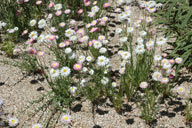In Flower This Week
A news sheet prepared by a Gardens' volunteer.
Numbers before each plant refer to temporary IFTW labels in the gardens.
Numbers in square brackets [ ] refer to garden bed Sections. Plants in flower are in bold type.
View past issues of 'In Flower This Week'.
10 December 2014
Rhodanthe chlorocephala subsp. rosea click for larger image |
We will walk to the new Asteraceae Garden today to see what is in flower. All plants are in Section 328.
- As you enter the Asteraceae Garden on your right is Cassinia aureonitens or Yellow Cassinia with flat yellow composite heads of flower on a plant with linear foliage. It grows naturally in eastern New South Wales, on sandy or alluvial soils, from Taree to Eden and west to the Blue Mountains.
- On your left is Senecio pinnatifolius var. pinnatifolius with yellow starbursts of flowers on grey divided foliage. This plant occurs over a large area of Australia, in Western Australia, South Australia, New South Wales, Queensland, Victoria and Tasmania.
- Brachyscome multifida ‘Breakoday’ is on your left with mauve flowers on small clumps of divided foliage.This cultivar is a popular daisy in many gardens.
- In a pot on your right is Brachyscome segmentosa with mauve daisies with gold centres on a groundcover mat. This daisy is endemic to Lord Howe Island, where it grows at higher altitudes.
- Brachyscome iberidifolia is in a pot on your right and is also scattered throughout the garden. It has deep purple flowers with black centres on thin tangled foliage. Swan River Daisy is an annual herb found in Western Australia. It occupies a large range, and the species can spread widely.
- Also in a pot on your right is Brachyscome ‘Pacific Reef’ with bright pink daisies with gold centres on blue-green foliage. This is a popular and hardy garden plant.
- Chrysocephalum apiculatum on your right has single gold flowerheads on a small bush. It is a perennial herb which is found in all States and Territories in Australia.
- Also on your right is Brachyscome rigidula with pale lilac flowers with gold centres. Commonly known as Leafy Daisy, it occurs widely in southeastern Australia at higher elevations.
- On the left is Xerochrysum viscosum with bright yellow daisies on sticky green foliage. It occurs in the wild generally west of the Great Dividing Range in New South Wales and Victoria.
- On both the left and right is Leptorhynchos squamatus with bright gold terminal flowers on a small plant. Known as Scaly Buttons, this plant occurs widely in southeastern Australia.
- On the left is Rhodanthe chlorocephala subsp. rosea with many pink flowers fading to white with gold centres. It is widely grown for its attractive flowers and foliage, and also because it is hardy and adaptable. The flowers are papery, long-lived and dry well. The plant is ephemeral, springing up whenever conditions are right e.g. during warm, sunny weeks any time of the year.
- Also on the left is Schoenia filifolia subsp. subulifolia, also known as Showy Everlasting, with cheerful yellow daisies on thin stems. This species is widespread in southern Western Australia
- On the right is Ammobium alatum with winged grey stems supporting white paper daisies with golden centres. This plant is native to eastern Australia. The small flower heads can be dried.
- Rhodanthe anthemoides on the left is a long lasting white daisy on attractive clumps of grey foliage. It is widespread in eastern Australia.
- Brachyscome multifida ‘Alba’ on your left as you exit the garden is a small white daisy with gold centres. It is also known as White Cut Leaf Daisy.
Rosalind Walcott
![Director of National Parks [logo]](../../../../images/dnp_90px.gif)







